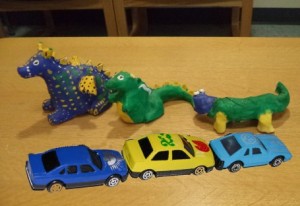Play is so amazing for learning. Play time with dinosaurs and cars was a great opportunity for figuring out one-to-one correspondence or matching. Besides counting and making a pattern sequence, this is another critical skill for math. Not only that, it’s important for language too.
 What is one-to-one correspondence? Just like it sounds, it’s matching one object to one other object. This is so obvious it seems like one of those times we could say ‘duh’ but it isn’t for young brains. Kids have to figure out that sometimes only one thing will go with one other thing. For instance, each number is one item and one word goes with one chunk of sound.
What is one-to-one correspondence? Just like it sounds, it’s matching one object to one other object. This is so obvious it seems like one of those times we could say ‘duh’ but it isn’t for young brains. Kids have to figure out that sometimes only one thing will go with one other thing. For instance, each number is one item and one word goes with one chunk of sound.
With some cars altogether in a line, it was easy to put one dinosaur to one car. Each dinosaur could be paired with different toys too, such as blocks or Lego people. Kids can make their own matches. Sometimes, kids will do this on their own, or when it’s appropriate, adults can also put items together and show kids how each dinosaur gets one thing. Kids may or may not try one to one matching at this time but even a few minutes will give the brain something to think about.
There are many opportunities in a day to practice this, such as one sock on one foot, each person at the table gets one plate, one kidlet per car seat, etc. The brain needs a great many of these to make the connection for one-to-one. It forms the basis for reading, one word and meaning goes to one squiggle bit. Think of how frequently we use it in a day. One person to one ticket on the bus According to R. Charlesworth and K. Lind, “One-to-one correspondence helps to solve difficulties….” It’s often the basis for social rules, such as one person at a time or everyone gets one turn first. . Now does it seem more important? Any one kidlet to one dinosaur in your child’s play?
